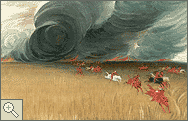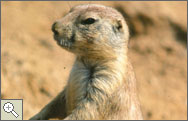
Both Lewis and Clark were of the Virginia planter class. Clark spent much of his youth on the Kentucky frontier, while Lewis lived near Monticello and had the great advantage of Jefferson's tutelage. In the journals, Lewis is the more writerly of the two writers. While Clark will make a simple note like "musquitors & knats verry troublesom,"
Lewis will refer to mosquitoes, gnats, and prickly pears as "our great trio of pests, equal to any three curses that ever poor Egypt labored under." Lewis often conveys emotional as well as objective truth--he tells what he feels about something and shows why. At the Great Falls of the Missouri, which he calls "the grandest sight I ever beheld," he attempts to capture the instantaneous beauty of the water’s motion: "Irregular and somewhat projecting rocks below receives the water in it's passage down and brakes it into a perfect white foam, which assumes a thousand forms in a moment, sometimes flying up in jets of sparkling foam to the hight of fifteen or twenty feet and are scarcely formed before large roling bodies of the same beaten and foaming water is thrown over and conceals them."
He then apologizes for the description: "I again viewed the falls and was so much disgusted with the imperfect idea which it conveyed of the scene that I determined to draw my pen across it and begin agin, but then reflected that I could not perhaps succeed better than pening the first impressions of the mind."
While he is far too hard on himself here, we can see Lewis and Clark struggling with a dual difficulty throughout the journals: as they try to get a handle on this new world, language itself sometimes slips away from them.
Even when we remember that English was not as standardized in the early 1800s as it is now, their writings are notable for irregularities of spelling, punctuation, and grammar. Clark's spelling is especially wild. In his entries, the Sioux, for instance, might appear as the "Sieoux," the "Seaux," the "Souixx," the "Seauex," the "Scioux," or the "Soues." He comes up with twenty-seven variations of this one-syllable word. In a single paragraph, Indians might come onto the scene as Siaux and depart as Seauex.
But any roughness in the journals is forgiven by the roughness of the journey. In his book Undaunted Courage, historian Stephen E. Ambrose reflects on one of the evenings in the mountains when the party made a meal of pack horse.
"It wasn't much," he writes. "But, sitting around the campfire, cold, hungry, exhausted, and miserable, Lewis summoned the energy to make significant additions to scientific knowledge (if he could get his journals back to civilization). He described the varied thrush, Steller's jay, the gray jay, the black woodpecker (known today as Lewis’s woodpecker), the blue grouse, the spruce grouse, and the Oregon ruffed grouse, as well as the mountain huckleberry, the Sitka alder, and the western red cedar (called "arborvitae" by Lewis). All but the thrush were unknown to science."
Lewis and Clark took note of 134 bird species in all, 51 of which were newly sighted in America. They described 178 new plants and wrote the first reports of 122 animals, including the jackrabbit, the mule deer, the coyote, the pronghorn antelope, and the bighorn sheep.
Whatever they lacked in literary gifts, they made up for in this diligence and in their hearty curiosity. A passage from Lewis on the magpie shows how the rigorous work of writing can reveal a subject as well as describe it. At a glance, the magpie is a black-and-white bird. Under Lewis's scrutiny, "the upper side of the wing... is of a dark blackis[h] or bluish green [sometimes] presenting as light orange yellow or bluish tint as it happens to be presented to different exposures of ligt."
When possible, Lewis and Clark described the new in terms of the familiar. In the journals, the magpie is the "size of a jack-daw." The mule deer "jumps like a goat." The bighorn is "more delicately formed" than the domestic sheep. The prairie dog's form is "that of the squirrel...[but] they bark at you as you approach them."
These reports served as more than information. In the book Acts of Discovery, Albert Furtwangler writes that Lewis and Clark, by applying the language of the known to the unknown, were starting to lay the groundwork for the coast-to-coast country that America would become. They were "uniting the western wren to the eastern wren, the trees rooted on the Pacific slopes of the Rockies to those rooted in Virginia."
|
 |
 |
 |

The Prarie got on fire and went with Such Violence & Speed as to Catch a man & woman & burn them to Death, Several escapd. among other a Small boy who was Saved by getting under a green Buffalow Skin.
—WILLIAM CLARK
|
 |
 |
 |
 |
 |
 |

Prairie Meadows Burning by George Catlin, 1832.
|
 |
 |

Smithsonian American Art Museum; gift of Mrs. Joseph Harrison, Jr.
|
 |
 |
 |
 |
 |

I have called [it] the barking squirrel...It's form is that of
the squirrel...[but] they bark at you as you approach them.
—MERIWETHER LEWIS
|
 |
 |
 |
 |
 |
 |

Photo of black-tailed prairie dog by Jessie Cohen. National Zoological Park, Smithsonian Institution.
|
 |
 |
 |
|

